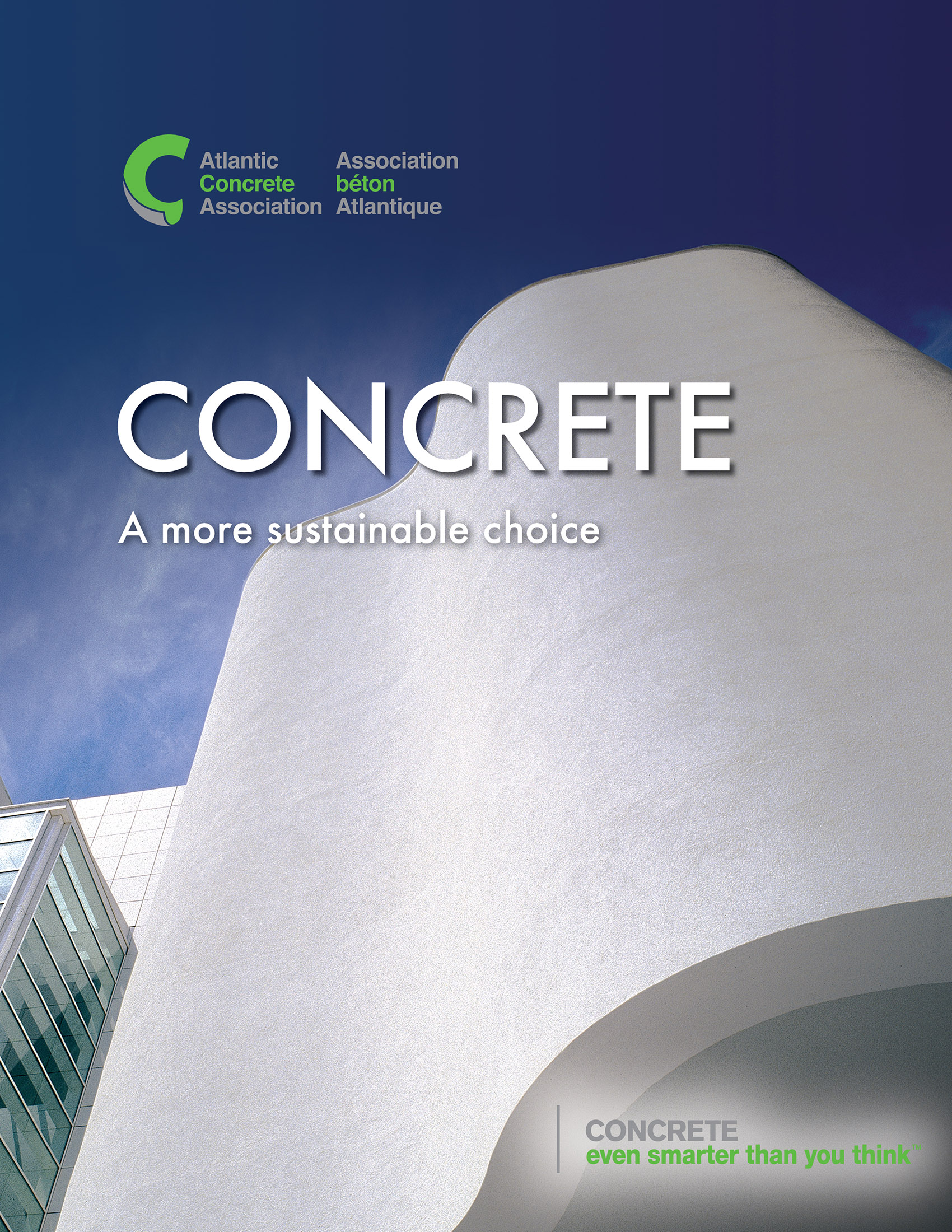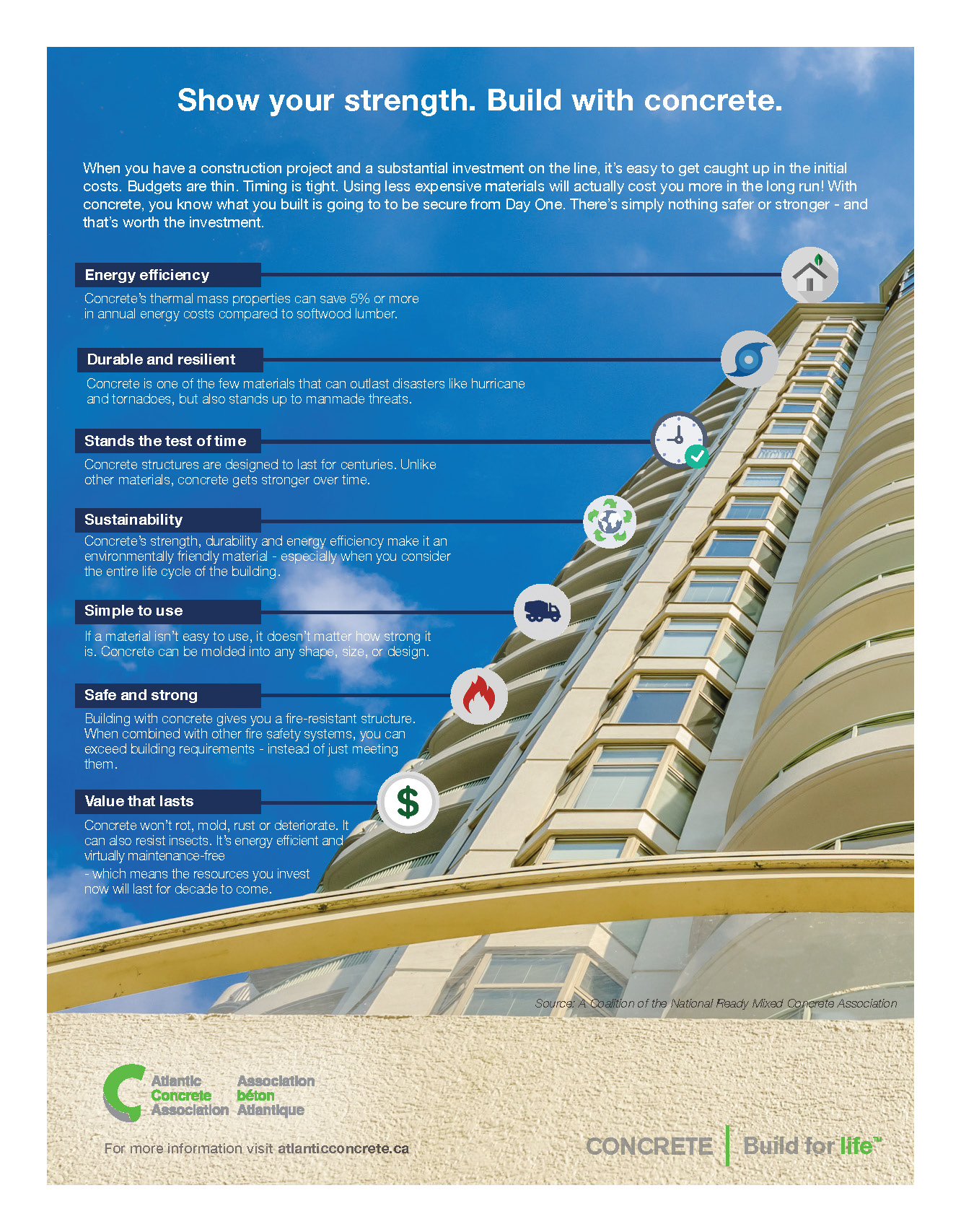 ConAtlantic will be hosting its 2024 event at the Delta Fredericton in NB!
ConAtlantic will be hosting its 2024 event at the Delta Fredericton in NB!
Each year members of the ACA (The Atlantic Concrete Association) come together for professional development, technical workshops and networking opportunities and to help discuss ways of continuously improving the growth and success of our industry! ConAtlantic provides educational and social initiatives while contributing to the professional development of our members.
COVID-19 put things on hold for awhile, but we hope to get together for a huge event in 2024! See you in Fredericton!

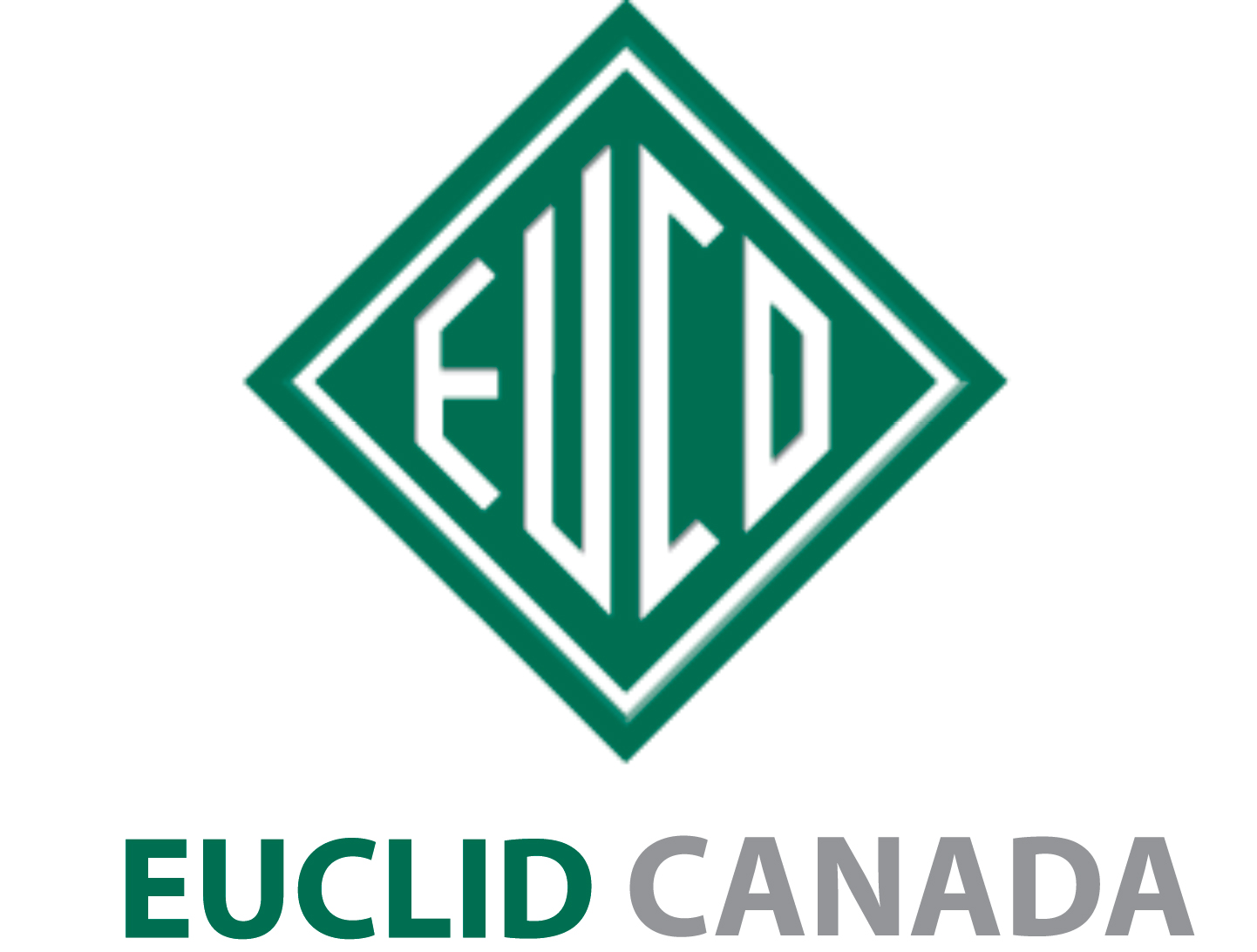

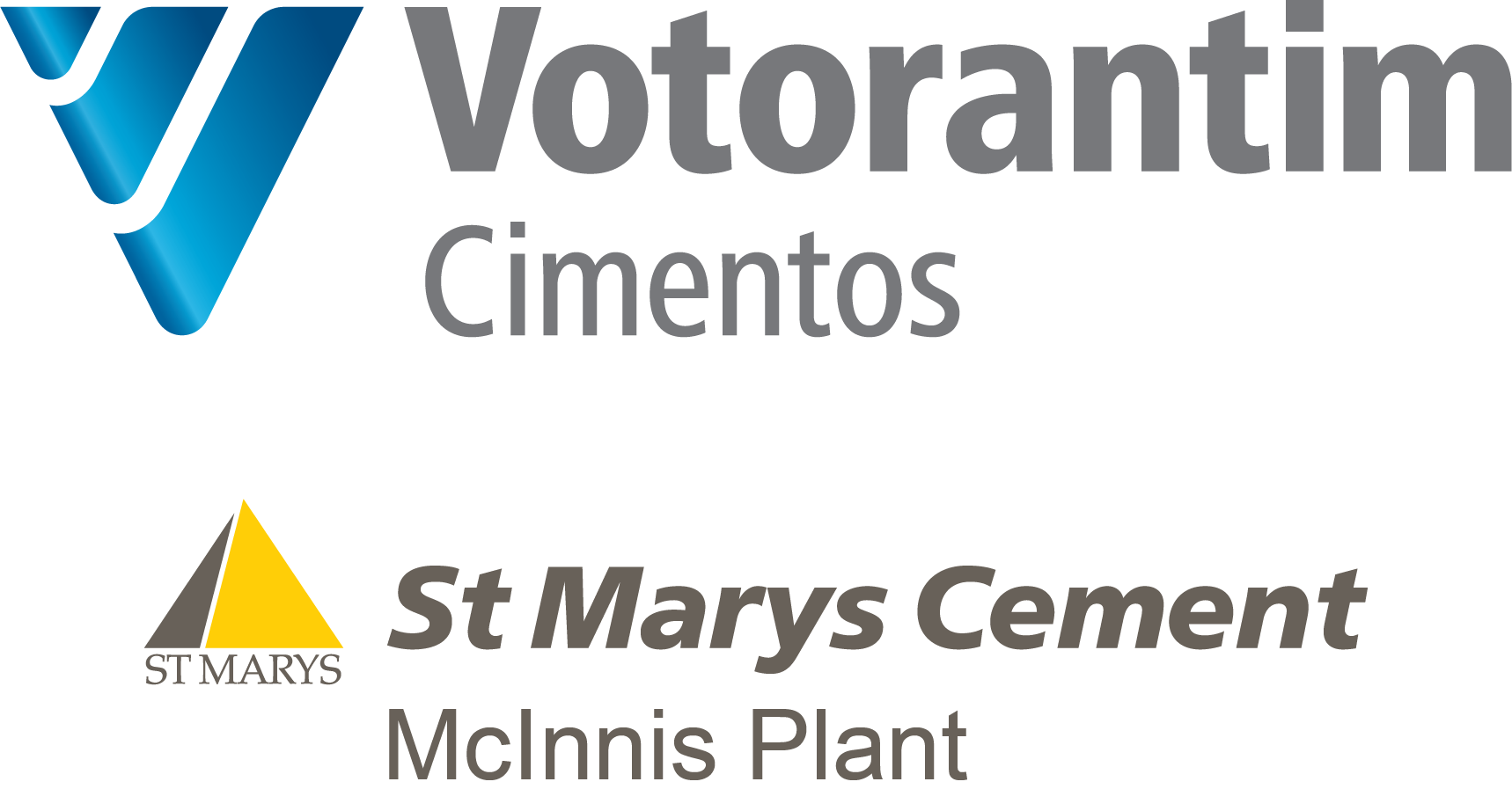









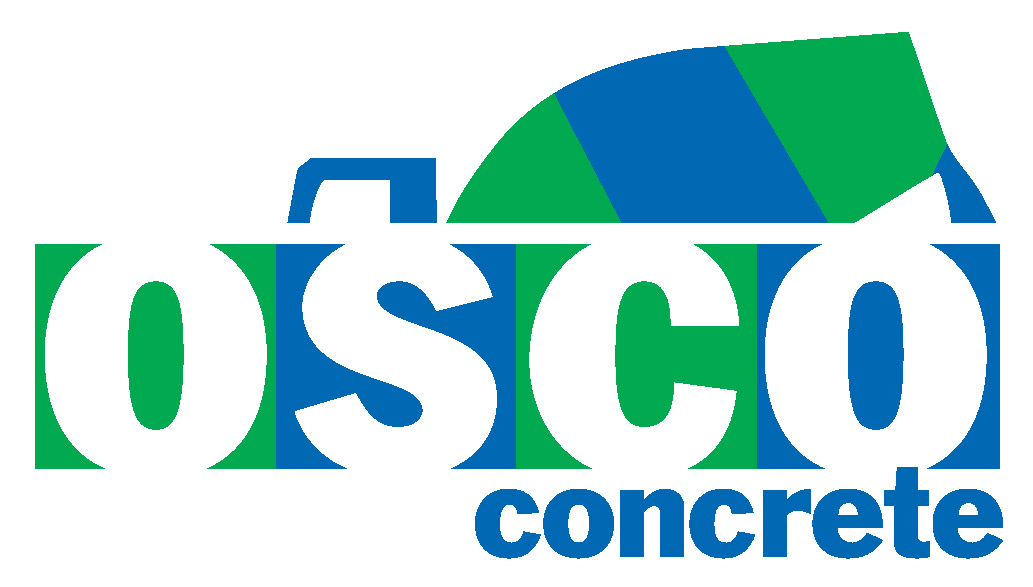






Please Note: Concrete Atlantic is not responsible for content information
When you have a construction project and a substantial investment on the line, it’s easy to get caught up in the initial costs. Budgets are thin. Timing is tight. Using less expensive materials will actually cost you more in the long run! With concrete, you know what you build is going to to be secure from Day One. There’s simply nothing safer or stronger - and that’s worth the investment.
Energy efficiency - Concrete’s thermal mass properties can save 5% or more in annual energy costs compared to softwood lumber.
Durable and resilient - Concrete is one of the few materials that can outlast disasters like hurricane and tornadoes, but also stands up to manmade threats.
Stands the test of time - Concrete structures are designed to last for centuries. Unlike other materials, concrete gets stronger over time.
Sustainability - Concrete’s strength, durability and energy efficiency make it an environmentally friendly material - especially when you consider the entire life cycle of the building.
Simple to use - If a material isn’t easy to use, it doesn’t matter how strong it is. Concrete can be molded into any shape, size, or design.
Safe and strong - Building with concrete gives you a fire-resistant structure. When combined with other fire safety systems, you can exceed building requirements - instead of just meeting them.
Value that lasts - Concrete won’t rot, mold, rust or deteriorate. It can also resist insects. It’s energy efficient and virtually maintenance-free - which means the resources you invest now will last for decade to come.
DOING OUR PART TO REDUCE GHGS
Cement production enjoys a relatively small footprint on many environmental metrics, however, it is energy and CO2 intensive. While cement is only a small component of a typical concrete mix, the cement sector is nonetheless deeply committed to reducing its GHGs and has made significant investments to that end.
In the last twenty years, we have reduced the energy required to make a tonne of cement by about 20%. Today, we are focusing on bringing lower carbon cements to market through a variety of strategies:
- Our recently introduced lower carbon cement Contempra reduces CO2 emissions by 10% compared to regular cement. If Contempra were to replace all cement consumed in Canada, it would save almost 1MT of GHG emissions per year;
- Substituting traditional fossil fuels, including coal, with lower carbon alternatives has the potential to yield significant GHG reductions across Canada. In leading jurisdictions, some cement facilities have achieved carbon intensity reductions of over 50% in the fuels they use; and,
- We are making deep investments in potentially transformative technologies such as carbon capture and reuse to transform concrete into a “carbon sink”.


SUSTAINABLE CONCRETE!
Building our communities in the age of climate change
The weather was once the worry of only farmers and parents dressing children for school. Today, climate change makes front page and business headlines. Stories of recent natural disasters and their impact on our economies have heightened everyone’s concern − and rightly so.
A 2011 United Nations report on disaster risk reduction identified that losses from disasters are rising faster than gains made through economic growth across many regions.
In Canada, the National Roundtable on the Environment and the Economy (NRTEE) predicted that by 2020, climate change impacts could cost the Canadian economy up to 1% of Gross Domestic Product (GDP), or $5 billion per year. That cost could climb to $43 billion per year by 2050. If 2013 was any indication, these predictions appear accurate. According to the Insurance Bureau of Canada, 2013 was the most expensive year on record for insurable losses in Canada, with $3.2 billion in weather-related claims. The 2013 Calgary flood alone is estimated to have cost upwards of $6 billion, including non-insurable losses.
A 2012 report from the Insurance Bureau of Canada stated that “climate change is likely responsible for the rising frequency and severity of extreme weather events, such as floods, storms, droughts and fires since warmer temperatures tend to produce more violent weather patterns.”
The scientific research indicates that our climate will continue to change, with rising temperatures and sea levels, fluctuating rainfall and snowfall patterns, and more unpredictable extremes ranging from floods to droughts and freezing winters. The certainty of that reality has a direct impact on how we define and grapple with the concept of sustainability.
While sustainability is most commonly understood in terms of reducing the immediate impact of human activity on the environment, climate change and other environmental and social pressures are illustrating that sustainability is an even more complex goal as we search for solutions responsive to a dynamic and changing world. As we strive to reduce greenhouse gases (GHGs) for example, we must also prepare for a world of more uncertain weather extremes wrought by changes to our climate that are by now inevitable.
Concrete thoughts:
- It takes less energy to produce concrete than it does to produce steel or wood according to a study conducted by the National Ready-Mixed Concrete Association and reported by the World Business Council for Sustainable Development.
- The production of cement – the primary ingredient of concrete – is responsible for 1.5% of Canada’s CO2 emissions, compared with 3% for the forest industry.
- Given the costs and challenges of shipping concrete, most concrete is produced very close to where it will be used. This reduces the need for fuel for transportation.
- Concrete is highly reflective. A high percentage of the light that hits concrete roads and walls is reflected, thereby helping to keep cities cooler and reduce the need for air conditioning.
- Heat moves very slowly through concretewalls and floors, thereby reducing swing in indoor temperatures.
- The industry increasingly uses waste products to the replace some of the conventional cement required in the production of concrete.
- The concrete industry has made important progress in its use of alternative fuels.
- The longevity and stability of concrete means that it requires less maintenance and it is rarely replaced.
For more information on the environmental benefits of concrete, please visit the Rediscovery Concrete website.
Environmental Product Declaration Document for Canadian Ready-Mixed Concrete
LEED® AND ENVIRONMENTAL PRODUCT DECLARATIONS
Since its inception, the LEED® green building program has been used to reduced environmental impacts of the built environment. LEED® has been a market transformation device affecting all sectors of the construction industry, including concrete production and construction.
The system is based on four certification levels (certified, silver, gold and platinum), allowing projects to earn points for environmentally friendly strategies employed during the design and construction process. Because of concrete’s versatility there are many applications where concrete can be used in a building project, from foundation and superstructure to sidewalks and parking lots. That means concrete can contribute to every credit category.
An Environmental Product Declaration (EPD) for building materials can earn your products valuable credits within the LEED® green building program meet a growing number of procurement requirements for governments and industry. Concrete is an important component of these credits. Using concrete can influence 25 of the 55 LEED® V4 credits and prerequisities and potentially contribute to as many as 74 of the 110 points available. Download the EPD document
Detailed information on the LEED® v4 and project certification process is available at www.usgbc.org or www.nrmca.org/sustainability or cagbc.org.
Environmental Product Declaration
Download the EPD document Document for Canadian Ready-Mixed Concrete
THINGS TO CONSIDER WITH CONCRETE
STRONG, DURABLE, AND LOW MAINTENANCE
Concrete products last decades longer than alternative building materials. Not only is concrete’s structural stability maintained for longer periods, it is non-combustible, preventing the spread of fire from one unit or one building to another. It is resistant to moisture and doesn’t rot or mold. And it is sufficiently strong to resist impacts, blasts and natural catastrophes like earthquakes, tornadoes and floods.
ENERGY-EFFICIENT
The ability of concrete products to store energy (their thermal mass) helps moderate interior temperature conditions, allowing a more constant temperature both in cold and hot regions. It improves a building’s “passive survivability” in the event that services such as power, heating fuel, or water are lost — minimizing energy demands for the city as a whole and reducing the GHG emissions from heating and cooling energy.
COMFORTABLE
Concrete products have intrinsic properties of acoustic insulation. This can help amplify sound within a space or dampen it between spaces. Concrete buildings can measurably reduce sound transmission between residential units, giving occupants more privacy.
EMISSION-FREE
An inert substance when cured, concrete is emission-free and will not emit any gas, toxic compounds or volatile organic compounds.
VERSATILE
While strong and functional when hardened, concrete’s plasticity when freshly mixed lets designers adapt it to whatever form, shape, surface and texture they can imagine. Innovations such as ultra-high performance concrete, photocatalytic concrete and pervious concrete are also enabling new and creative uses.
IDEAL FOR ADAPTIVE REUSE
Because of concrete’s strength, sound attenuation, and fire resistance, concrete buildings can easily be converted to other occupancy types during their service life. Reusing buildings in this way can help limit urban sprawl and further contributes to the conservation of our resources and preservation of the environment.
COST-EFFECTIVE
Thanks to their durability, resilience, low maintenance requirements and energy-efficiency, structures built with concrete products reduce operating costs related to operational energy consumption, maintenance, and rebuilding following disasters. Insurance costs for concrete buildings during the construction and operating phases have also been shown to be significantly lower than for buildings constructed with combustible, moisture-sensitive materials.
100% RECYCLABLE
Concrete products can be recycled as aggregate — for use as sub-base material in roadbeds and parking lots, for gabion walls, as riprap to protect shorelines or in other applications — or as granular material, thereby reducing the amount of material that is landfilled and the need for virgin materials in new construction.
PRODUCED LOCALLY
Concrete is typically manufactured within 160 kilometers of a project site, using local resources. This greatly minimizes shipping and pollution and makes a significant contribution to the local economy.
Among its conclusions, the study found that up to 72% of carbon emissions from wood products may not be accounted for in commercial Life-cycle Assessments (LCA). When these emissions are taken into account, concrete’s embodied carbon footprint could be up to 6% less intensive than that of wood products, challenging the assumption that wood materials are inherently less carbon intensive than steel or concrete.
LOGGING SCARS,Wildland League, December 2019,
Further evidence about the hidden carbon footprint of wood was released by Toronto- based Wildlands League. Titled “Logging Scars,” the research found that the wood industry’s reforestation efforts are significantly less successful than assumed.
BOREAL LOGGING SCARS MAP, Wildlands League, July 2020
Other Sources and References:
Canada’s managed forests have turned into super-emitters, and 2018 set a record, National Observer, June 2020,
Wooden high-rises don’t guarantee reduced emissions, Peter Fairley, Crosscut, May 2020,
The Logging Loophole: How the Logging Industry’s Unregulated Carbon Emissions Undermine Canada’s Climate Goals report, NRDC, Environmental Defence, Nature Canada, July 2020
To save our climate we need taller trees not taller wooden buildings, John Talberth, Center for Sustainable Economy, February 2020,
Canada uses ‘creative accounting’ to push forest emissions off the books, Barry Saxifrage, The Energy Mix, April 2020,
Clearcutting the planet’s carbon pools, Tzeporah Berman, Corporate Knights, May 2020,
Canada is failing to track the true climate cost of clearcut logging in boreal: report, Matt Simmons, The Narwhal, July 2020,
Here’s what’s happening to BC forests, David Broadland, Focus on Victoria, August 2020,
CO2 emissions from forestry are a surging climate threat. Ottawa needs to act, Barry Saxifrage, National Observer, November 2020,
Carbon Sequestration in Forest Based Products,, Pacific Northwest Building Resilience Coalition, 2018, Globe Advisors.
The Great American Stand, US Forests and the Climate Emergency, Dogwood Alliance, 2017, Executive Summary,
Resources on concrete carbonation
(Re)Carbonation, A little-known fact about cement is that it is a carbon sink!, CEMBUREAU,
Substantial global carbon uptake by cement carbonation, Nature Geoscience, November 2016,
Please Note: Concrete Atlantic is not responsible for content information
Please feel free to ultilize these publications for your own use. High resolution (print quality) artwork is available by calling the ACA Office.

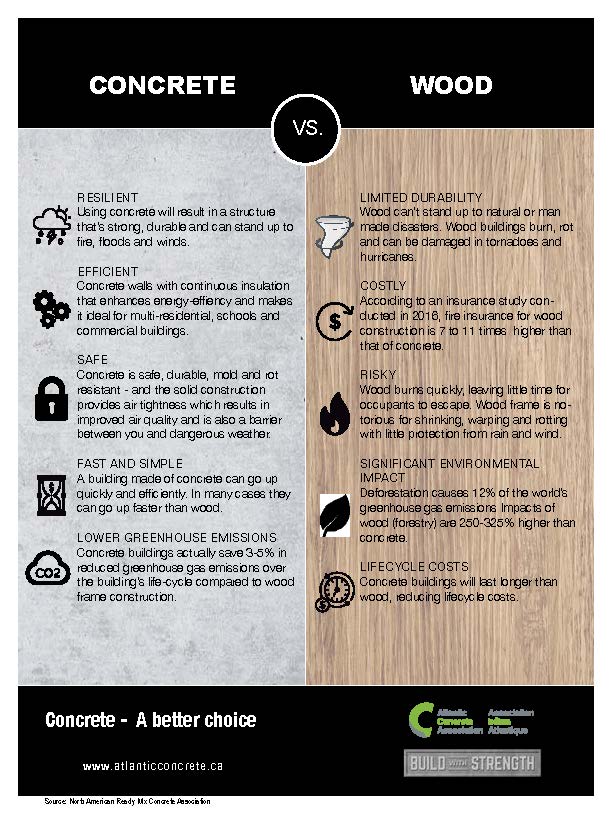
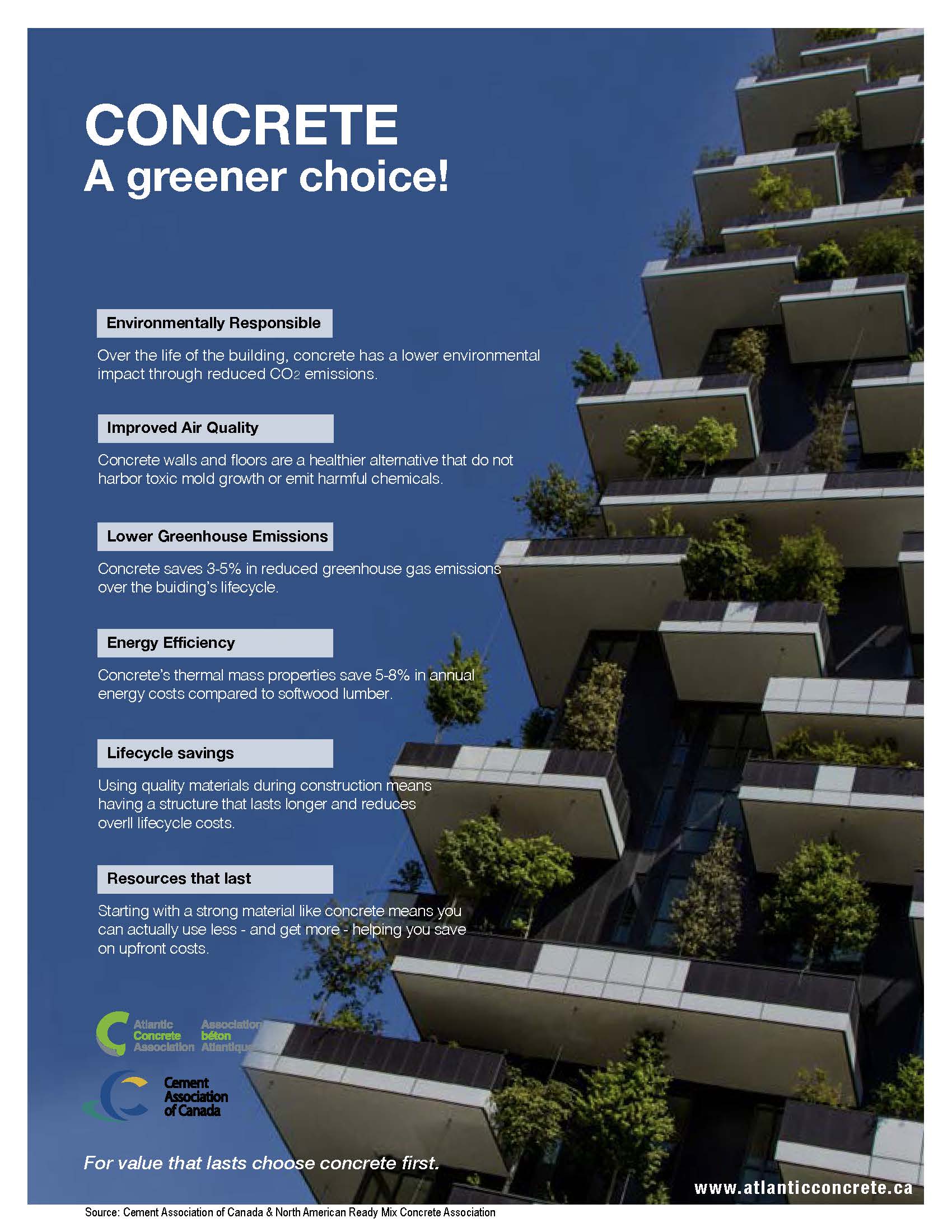


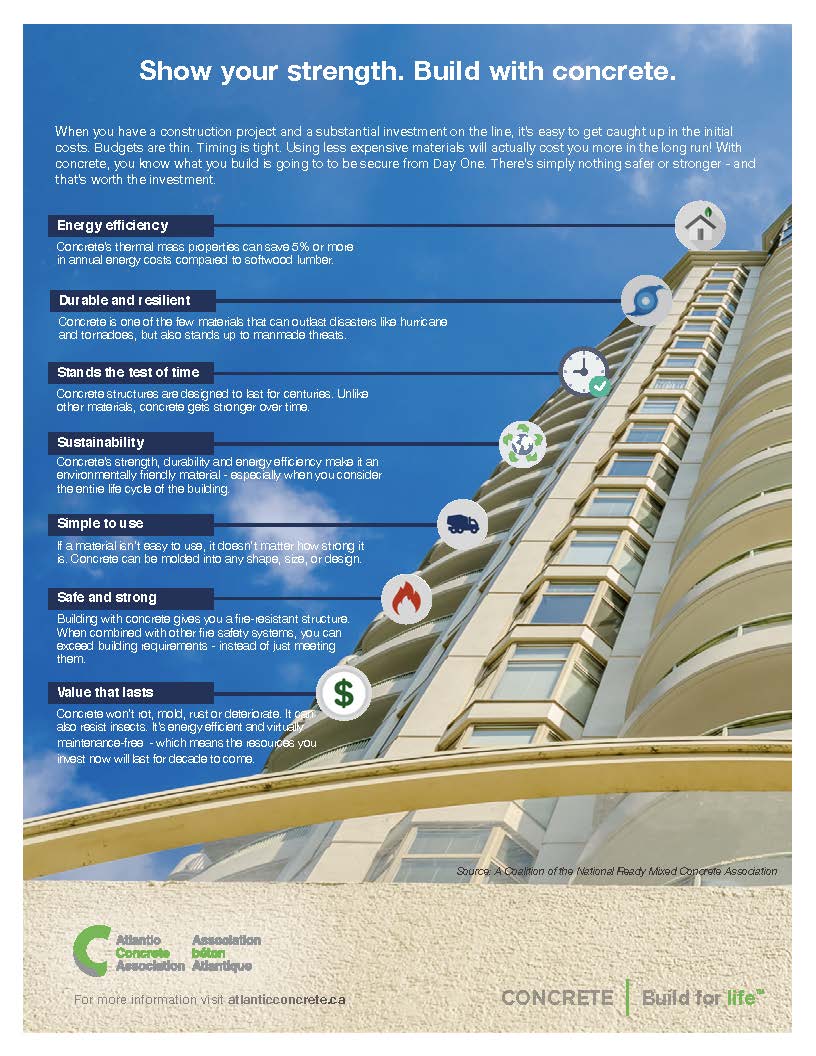
CARBON SEQUESTRATION IN WOOD BUILDING PRODUCTS, PRESENTATION BY BRENT McGRATH
Watch Presentation
RESILIENCE: ADAPTING TO CLIMATE CHANGE - DR. BLAIR FELTMATE
Watch Presentation
CCEPA: HISTORY OF SUSTAINABLE DEVELOPMENT - DR. BLAIR FELTMATE
Watch Presentation
CatIQ's CATASTROPHE CONFERENCE - DR. BLAIR FELTMATE
Watch Presentation
CONCRETE MIXER DRIVER RECRUITMENT VIDEO
Watch Short Video
Watch Long Video
A DAY IN THE LIFE OF A READY MIX DRIVER
Watch Short Video
Watch Long Video
NEW - CPCI ENERGY GUIDE![]() Read the Guide
Read the Guide
ENVIRONMENTAL PRODUCT DECLARATION DOCUMENT - for the Canadian Ready-Mixed Industry
Download the EPD document
STUDY OF INSURANCE COSTS FOR MID-RISE WOOD FRAME AND CONCRETE RESIDENTIAL BUILDINGS![]() Read the Summary
Read the Summary![]() Read the full report
Read the full report
STUDY OF INSURANCE COSTS FOR MID-RISE WOOD FRAME AND CONCRETE RESIDENTIAL BUILDINGS![]() Read the Executive Summary
Read the Executive Summary![]() Read the full Report
Read the full Report
DETAILED COST ANALYSIS BETWEEN WOOD AND CONCRETE CONSTRUCTION ![]() Read Report.pdf
Read Report.pdf
NOTICE OF CHANGE FOR PLANT CERTIFICATION CSA STANDARD A23.1-14 - APRIL, 2016
Delivery Ticket Requirements ![]() mem_aca_changes_a231_deliveryslip_201604191.pdf
mem_aca_changes_a231_deliveryslip_201604191.pdf
CONCRETE EXPOSURE CLASSES![]() Download the report
Download the report
SLAB SURFACE PREVENTION REPAIR![]() Download the report
Download the report
SUSTAINABILITY, WOOD AND THE ENVIRONMENT![]() Download the report
Download the report
CANADIAN CEMENT INDUSTRY SUSTAINABILITY REPORT![]() ENGLISH_FINAL_2010_SD_Report_Mar17.pdf
ENGLISH_FINAL_2010_SD_Report_Mar17.pdf
MATERIAL SELECTION MATTERS SEMINAR – PRESENTED BY JOHN STRAUBE, PHD., P.ENG., RDH BUILDING SCIENCE LABORATORIES
This seminar presentation provides up-to-date building science information about material selection and how to apply building science principles to construct resilient, durable, energy efficient and healthy buildings.
View the presentation…
LIFE CYCLE ASSESSMENT OF CONTRMPRA (PORTLAND-LIMESTONE CEMENT) AND REGULAR CEMENT
AN ENVIRONMENTAL LIFE CYCLE ASSESSMENT OF PORTLAND-LIMESTONE AND ORDINARY PORTLAND CEMENTS IN CONCRETE
A cradle-to-gate Life Cycle Assessment study of both Portland-limestone cement and ordinary Portland cement released by Athena Sustainable Materials Institute in 2014 demonstrates that Portland-limestone cement has lower impacts in all indicators and is about 10% better in greenhouse gas emissions. ![]() Read the technical brief
Read the technical brief
CLIMATE CHANGE ADAPTATION & INFRASTRUCTURE
CAC OPED ON FACING THE CHALLENGE OF ADAPTING TO CLIMATE CHANGE IN CANADA
LIFE CYCLE ASSESSMENT (LCA) – BUILDINGS
AN ENVIRONMENTAL LIFE CYCLE ASSESSMENT OF PORTLAND-LIMESTONE AND ORDINARY PORTLAND CEMENTS IN CONCRETE
A cradle-to-gate Life Cycle Assessment study of both Portland-limestone cement and ordinary Portland cement released by Athena Sustainable Materials Institute in 2014 demonstrates that Portland-limestone cement has lower impacts in all indicators and is about 10% better in greenhouse gas emissions. ![]() Read the technical brief
Read the technical brief
ATHENA INSTITUTE OFFERS NEW GUIDE TO LCA CREDITS IN GREEN BUILDING PROGRAMS![]() Read the guide
Read the guide ![]() Read the report
Read the report
LIFE CYCLE ASSESSMENT OF PRECAST CONCRETE COMMERCIAL BUILDINGS
Athena Sustainable Institute, Morrison Hershfield, Venta, Glaser & Associates, CPCI![]() Read the report
Read the report
LIFE CYCLE ASSESSMENT FOR SUSTAINABLE DESIGN OF PRECAST CONCRETE COMMERCIAL BUILDINGS IN CANADA
Athena Sustainable Institute, Morrison Hershfield, CPCI![]() Read the report
Read the report
LIFE CYCLE ASSESSMENT (LCA) OF BUILDINGS
Concrete Sustainability Hub | Massachusetts Institute of Technology![]() Read the Report
Read the Report
MIT CONCRETE SUSTAINABILITY HUB![]() Visit the Concrete Sustainability Hub
Visit the Concrete Sustainability Hub
LIFE CYCLE ASSESSMENT (LCA) - PAVEMENTS
ATHENA SUSTAINABLE MATERIALS INSTITUTE RELEASES UPDATE TO ITS PAVEMENT LCA TOOL WITH A NEW NAME AND MANY NEW FEATURES
The North American pioneer in construction sector LCA today released Version 2.1 of ‘Pavement LCA’, formerly known as the Impact Estimator for Highways, with a variety of new features including US locations and sample projects. ![]() Read more and access the software
Read more and access the software
ATHENA SUSTAINABLE MATERIALS INSTITUTE IMPACT ESTIMATOR FOR HIGHWAYS - VERSION 2.0
The Athena Sustainable Materials Institute Impact Estimator for Highways provides quick and easy Life Cycle Assessment results for Canadian roadways. ![]() Read more and access the software
Read more and access the software
EQUIVALENT PAVEMENT STRUCTURAL DESIGN MATRIX AND LCCA FOR MUNICIPAL ROADWAYS
Updated reports for municipal roadways are now available:
• Nova Scotia 2013 (updated 2015)
• Ontario 2011 (updated 2015)
• Quebec 2012 (updated 2015)
• Alberta 2015
• British Columbia 2016
LIFE CYCLE ASSESSMENT (LCA) OF HIGHWAY PAVEMENTS
Concrete Sustainability Hub | Massachusetts Institute of Technology![]() Read the Report
Read the Report
ATHENA SUSTAINABLE MATERIALS INSTITUTE - A LIFE CYCLE PERSPECTIVE ON CONCRETE AND ASPHALT ROADWAYS: EMBODIED PRIMARY ENERGY AND GLOBAL WARMING POTENTIAL
MIT CONCRETE SUSTAINABILITY HUB![]() Visit the Concrete Sustainability Hub
Visit the Concrete Sustainability Hub
NATIONAL CONCRETE PAVEMENT TECHNOLOGY CENTER
Visit the National Concrete Pavement Technology Center
MANUFACTURING PROCESS RESEARCH
ALTERNATIVE ENERGY SOURCES IN CEMENT MANUFACTURING – A SYSTEMATIC REVIEW OF THE BODY OF KNOWLEDGE
Network for Business Sustainability, 2011![]() Read the Report
Read the Report
THE CEMENT SUSTAINABILITY INITIATIVE 2012 REPORT
World Business Council for Sustainable Development
In 2002, the founding members of the World Business Council for Sustainable Development’s Cement Sustainability Initiative (CSI) published their Agenda for Action. It sets out a program of work, focusing on certain specific areas. In each area, there are two kinds of action: joint projects, on which a group of companies will work together to tackle a specific environmental or social issue; and individual actions, which will be implemented by each company in its own operations (including target setting and performance reporting), applying both innovation and best practice.
This Progress Report provides a snapshot of CSI’s achievements over the past ten years, as well as an outlook onto the future issues the cement industry will need to tackle, how the CSI and its member companies are planning to respond to changing and new sustainability challenges.![]() Read the Report
Read the Report

